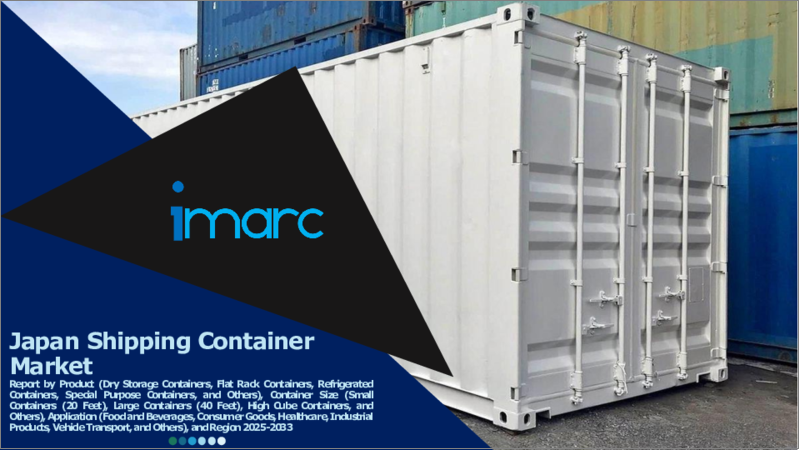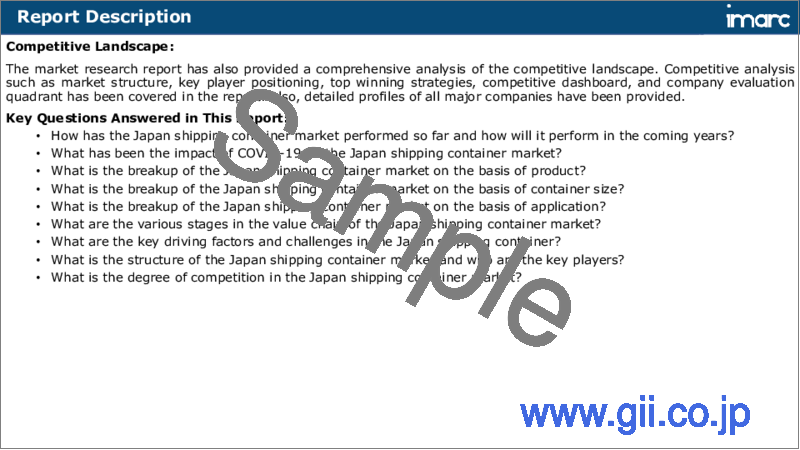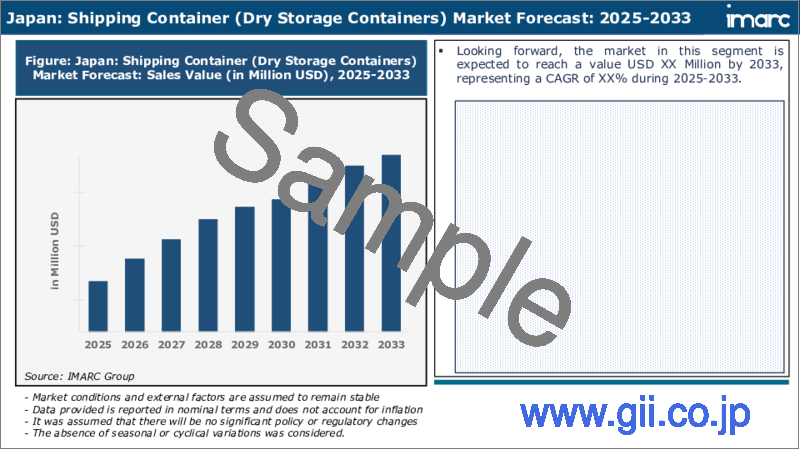|
|
市場調査レポート
商品コード
1609715
日本の輸送用コンテナ市場レポート:製品、コンテナサイズ、用途、地域別、2025年~2033年Japan Shipping Container Market Report by Product, Container Size (Small Containers, Large Containers, High Cube Containers, and Others), Application, and Region 2025-2033 |
||||||
カスタマイズ可能
|
|||||||
| 日本の輸送用コンテナ市場レポート:製品、コンテナサイズ、用途、地域別、2025年~2033年 |
|
出版日: 2024年12月05日
発行: IMARC
ページ情報: 英文 122 Pages
納期: 5~7営業日
|
- 全表示
- 概要
- 目次
日本の輸送用コンテナ市場の市場規模は2024年に6億9,210万米ドルに達しました。今後、IMARC Groupは、市場は2033年までに11億6,300万米ドルに達し、2025年から2033年にかけて5.3%の成長率(CAGR)を示すと予測しています。物流における二酸化炭素排出量を削減するための効率的で持続可能な輸送ソリューションに対する需要の発展、スマートコンテナソリューションの人気の高まり、革新的なラストマイル配送ソリューションの市場開拓の増加は、市場を牽引する主な要因のいくつかです。
本レポートで扱う主な質問
- 日本の輸送用コンテナ市場はこれまでどのように推移し、今後どのように推移するのか?
- COVID-19が日本の輸送用コンテナ市場に与えた影響は?
- 日本の輸送用コンテナ市場の製品別構成比は?
- 日本の輸送用コンテナ市場の容器サイズ別構成比は?
- 日本の輸送用コンテナ市場の用途別の内訳は?
- 日本の輸送用コンテナ市場のバリューチェーンにはどのような段階がありますか?
- 日本向け輸送用コンテナの主な促進要因と課題は何か?
- 日本の輸送用コンテナ市場の構造と主要プレーヤーは?
- 日本の輸送用コンテナ市場における競合の程度は?
目次
第1章 序文
第2章 調査範囲と調査手法
- 調査の目的
- ステークホルダー
- データソース
- 市場推定
- 調査手法
第3章 エグゼクティブサマリー
第4章 日本の輸送用コンテナ市場-イントロダクション
- 概要
- 市場力学
- 業界動向
- 競合情報
第5章 日本の輸送用コンテナ市場情勢
- 過去および現在の市場動向(2019年~2024年)
- 市場予測(2025年~2033年)
第6章 日本の輸送用コンテナ市場- 製品別内訳
- 乾燥保管容器
- フラットラックコンテナ
- 冷蔵コンテナ
- 特殊用途コンテナ
- その他
第7章 日本の輸送用コンテナ市場- コンテナサイズ別の内訳
- 小型コンテナ(20フィート)
- 大型コンテナ(40フィート)
- ハイキューブコンテナ
- その他
第8章 日本の輸送用コンテナ市場- 用途別の内訳
- 食品・飲料
- 消費財
- ヘルスケア
- 工業製品
- 車両輸送
- その他
第9章 日本の輸送用コンテナ市場-競合情勢
- 概要
- 市場構造
- 市場プレーヤーのポジショニング
- 主要成功戦略
- 競争ダッシュボード
- 企業評価象限
第10章 主要企業のプロファイル
第11章 日本の輸送用コンテナ市場- 業界分析
- 促進要因・抑制要因・機会
- ポーターのファイブフォース分析
- バリューチェーン分析
第12章 付録
Japan shipping container market size reached USD 692.1 Million in 2024. Looking forward, IMARC Group expects the market to reach USD 1,163.0 Million by 2033, exhibiting a growth rate (CAGR) of 5.3% during 2025-2033. The growing demand for efficient and sustainable transportation solutions to reduce the carbon footprint of logistic operations, rising popularity of smart container solutions, and increasing development of innovative last-mile delivery solutions represent some of the key factors driving the market.
A shipping container is a large, standardized metal box designed for the efficient and secure transportation of goods. It comprises a dry band container, high cube container, and flat rack container, which has collapsible sides that allow for loading from the top or sides. It also consists of open-top containers, where cargo is loaded from the top using a crane. It includes refrigerated containers, which are equipped with refrigeration units to control temperature and are used for transporting perishable goods like fruits, vegetables, or pharmaceuticals. It encompasses tank containers, which are designed to transport liquids or gases and features a cylindrical stainless-steel tank within a rectangular frame. It comes in various sizes, but the most common are the twenty-foot equivalent unit (TEU) and the forty-foot equivalent unit (FEU). It is constructed to withstand the rigors of long-distance travel, ensuring the safety of goods during transit. It is designed with several aspects, including standard dimensions, structural integrity, stackability, and compatibility with different modes of transportation. It improves the logistics and transportation industries, enabling the efficient movement of goods across distances. It conducts efficient loading and unloading processes to reduce time and increase throughput of the supply chain. It is also used for temporary housing, on-site storage, and even as the building blocks for innovative architectural projects.
Japan Shipping Container Market Trends:
At present, the increasing demand for efficient and sustainable transportation solutions to reduce the carbon footprint of logistic operations represents one of the crucial factors impelling the growth of the market. Besides this, the rising adoption of eco-friendly container materials made of composite materials and lightweight alloys, which not only enhance fuel efficiency but also contribute to overall sustainability goals, is contributing to the market growth. In addition, the growing interest in innovative container designs that optimize space utilization, improve efficiency, and reduce the need for excess shipping capacity is offering a favorable market outlook in the country. Apart from this, the increasing popularity of smart container solutions that leverage internet of things (IoT) devices, sensors, and real-time tracking systems to enable better visibility into the supply chain, facilitating improved logistics planning, enhanced security, and reduced instances of cargo damage or loss is supporting the market growth. The adoption of blockchain technology is also gaining momentum, providing a secure and transparent platform for managing container-related transactions and documentation. Additionally, the rising development of innovative last-mile delivery solutions and the optimization of supply chain processes of the e-commerce sector to meet the evolving needs of the masses is strengthening the market growth. Moreover, the increasing containerization of goods as a preferred method of transporting commodities due to its cost-effectiveness and efficiency is bolstering the market growth in the country.
Japan Shipping Container Market Segmentation:
Product Insights:
- Dry Storage Containers
- Flat Rack Containers
- Refrigerated Containers
- Special Purpose Containers
- Others
Container Size Insights:
- Small Containers (20 Feet)
- Large Containers (40 Feet)
- High Cube Containers
- Others
Application Insights:
- Food and Beverages
- Consumer Goods
- Healthcare
- Industrial Products
- Vehicle Transport
- Others
Competitive Landscape:
The market research report has also provided a comprehensive analysis of the competitive landscape. Competitive analysis such as market structure, key player positioning, top winning strategies, competitive dashboard, and company evaluation quadrant has been covered in the report. Also, detailed profiles of all major companies have been provided.
Key Questions Answered in This Report:
- How has the Japan shipping container market performed so far and how will it perform in the coming years?
- What has been the impact of COVID-19 on the Japan shipping container market?
- What is the breakup of the Japan shipping container market on the basis of product?
- What is the breakup of the Japan shipping container market on the basis of container size?
- What is the breakup of the Japan shipping container market on the basis of application?
- What are the various stages in the value chain of the Japan shipping container market?
- What are the key driving factors and challenges in the Japan shipping container?
- What is the structure of the Japan shipping container market and who are the key players?
- What is the degree of competition in the Japan shipping container market?
Table of Contents
1 Preface
2 Scope and Methodology
- 2.1 Objectives of the Study
- 2.2 Stakeholders
- 2.3 Data Sources
- 2.3.1 Primary Sources
- 2.3.2 Secondary Sources
- 2.4 Market Estimation
- 2.4.1 Bottom-Up Approach
- 2.4.2 Top-Down Approach
- 2.5 Forecasting Methodology
3 Executive Summary
4 Japan Shipping Container Market - Introduction
- 4.1 Overview
- 4.2 Market Dynamics
- 4.3 Industry Trends
- 4.4 Competitive Intelligence
5 Japan Shipping Container Market Landscape
- 5.1 Historical and Current Market Trends (2019-2024)
- 5.2 Market Forecast (2025-2033)
6 Japan Shipping Container Market - Breakup by Product
- 6.1 Dry Storage Containers
- 6.1.1 Overview
- 6.1.2 Historical and Current Market Trends (2019-2024)
- 6.1.3 Market Forecast (2025-2033)
- 6.2 Flat Rack Containers
- 6.2.1 Overview
- 6.2.2 Historical and Current Market Trends (2019-2024)
- 6.2.3 Market Forecast (2025-2033)
- 6.3 Refrigerated Containers
- 6.3.1 Overview
- 6.3.2 Historical and Current Market Trends (2019-2024)
- 6.3.3 Market Forecast (2025-2033)
- 6.4 Special Purpose Containers
- 6.4.1 Overview
- 6.4.2 Historical and Current Market Trends (2019-2024)
- 6.4.3 Market Forecast (2025-2033)
- 6.5 Others
- 6.5.1 Historical and Current Market Trends (2019-2024)
- 6.5.2 Market Forecast (2025-2033)
7 Japan Shipping Container Market - Breakup by Container Size
- 7.1 Small Containers (20 Feet)
- 7.1.1 Overview
- 7.1.2 Historical and Current Market Trends (2019-2024)
- 7.1.3 Market Forecast (2025-2033)
- 7.2 Large Containers (40 Feet)
- 7.2.1 Overview
- 7.2.2 Historical and Current Market Trends (2019-2024)
- 7.2.3 Market Forecast (2025-2033)
- 7.3 High Cube Containers
- 7.3.1 Overview
- 7.3.2 Historical and Current Market Trends (2019-2024)
- 7.3.3 Market Forecast (2025-2033)
- 7.4 Others
- 7.4.1 Historical and Current Market Trends (2019-2024)
- 7.4.2 Market Forecast (2025-2033)
8 Japan Shipping Container Market - Breakup by Application
- 8.1 Food and Beverages
- 8.1.1 Overview
- 8.1.2 Historical and Current Market Trends (2019-2024)
- 8.1.3 Market Forecast (2025-2033)
- 8.2 Consumer Goods
- 8.2.1 Overview
- 8.2.2 Historical and Current Market Trends (2019-2024)
- 8.2.3 Market Forecast (2025-2033)
- 8.3 Healthcare
- 8.3.1 Overview
- 8.3.2 Historical and Current Market Trends (2019-2024)
- 8.3.3 Market Forecast (2025-2033)
- 8.4 Industrial Products
- 8.4.1 Overview
- 8.4.2 Historical and Current Market Trends (2019-2024)
- 8.4.3 Market Forecast (2025-2033)
- 8.5 Vehicle Transport
- 8.5.1 Overview
- 8.5.2 Historical and Current Market Trends (2019-2024)
- 8.5.3 Market Forecast (2025-2033)
- 8.6 Others
- 8.6.1 Historical and Current Market Trends (2019-2024)
- 8.6.2 Market Forecast (2025-2033)
9 Japan Shipping Container Market - Competitive Landscape
- 9.1 Overview
- 9.2 Market Structure
- 9.3 Market Player Positioning
- 9.4 Top Winning Strategies
- 9.5 Competitive Dashboard
- 9.6 Company Evaluation Quadrant
10 Profiles of Key Players
- 10.1 Company A
- 10.1.1 Business Overview
- 10.1.2 Product Portfolio
- 10.1.3 Business Strategies
- 10.1.4 SWOT Analysis
- 10.1.5 Major News and Events
- 10.2 Company B
- 10.2.1 Business Overview
- 10.2.2 Product Portfolio
- 10.2.3 Business Strategies
- 10.2.4 SWOT Analysis
- 10.2.5 Major News and Events
- 10.3 Company C
- 10.3.1 Business Overview
- 10.3.2 Product Portfolio
- 10.3.3 Business Strategies
- 10.3.4 SWOT Analysis
- 10.3.5 Major News and Events
- 10.4 Company D
- 10.4.1 Business Overview
- 10.4.2 Product Portfolio
- 10.4.3 Business Strategies
- 10.4.4 SWOT Analysis
- 10.4.5 Major News and Events
- 10.5 Company E
- 10.5.1 Business Overview
- 10.5.2 Product Portfolio
- 10.5.3 Business Strategies
- 10.5.4 SWOT Analysis
- 10.5.5 Major News and Events
11 Japan Shipping Container Market - Industry Analysis
- 11.1 Drivers, Restraints, and Opportunities
- 11.1.1 Overview
- 11.1.2 Drivers
- 11.1.3 Restraints
- 11.1.4 Opportunities
- 11.2 Porters Five Forces Analysis
- 11.2.1 Overview
- 11.2.2 Bargaining Power of Buyers
- 11.2.3 Bargaining Power of Suppliers
- 11.2.4 Degree of Competition
- 11.2.5 Threat of New Entrants
- 11.2.6 Threat of Substitutes
- 11.3 Value Chain Analysis






